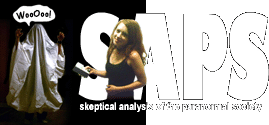False Memory Implantation
A look at whether we believe because it's what we saw, or because it's what we're told we saw.
False memory implantation refers to the ability of a person to alter one's memory of events. Sometimes these events are fictional in their entirety. Other times, the times we are interested in, have to do with altering slightly what actually happened. For example, if a vase falls off a table that you and I are standing next to, and as soon as it falls I say, "Oh my God, that vase lifted itself six inches in the air and threw itself at the ground! That's amazing!", then I am attempting to implant a false memory. There is a perfectly logical explanation for what happened, without involving any strange occurence. But my repetition of what I "saw" to you will sway your thinking, especially if it is done immediately after the occurence. When the mind observes something, it goes through a process to evaluate what happened. If I manage to disturb your evaluation before your mind has processed the information, then I will succeed in changing your memory.
Another type of false memory implantation has to do with semantics. This is called the "Misinformation Effect". Everything about how you answer questions following observing an occurence, like the vase, has to do with how I phrase the question. For example, if, after the vase falls, I say "How high did the vase levitate before falling?" then your answer will be based on the vase levitating, even if it didn't at all.
An interesting psychological factor to note in these processes is the desire of the mind to categorize occurences. This is used in Media Priming - when the media focuses on particular events to strengthen public opinion, and shoves other equally valid events to the background. These change the focus of the public to whatever the media desires - we can't have an opinion if we don't know about it.
Thinking of various paranormal shows, we can see the evidence of all these things onscreen.
Example One: When something questionable happens, like a shadow crossing the camera, if the initial reaction is "It's a ghost," and it is repeated often, we may come to believe it, especially if...
Example Two: The statement disrupts the mind when it is evaluating and...
Example Three: The only questions asked and options given refer to something paranormal and...
Example Four: Any evidence to the contrary is shoved to the back burner.
So, in order to make you believe in a paranormal occurence, I could do this:
Without you seeing me, I nudge a table that has a vase on it with my foot. As it crashes to the ground, I cry "Oh, the vase levitated! Did you see that?!" (This is the best way to phrase it, as not only does it implant what I want you to believe, but also asks for an immediate response before you've had time to evaulate and answer.) Then, standing over the vase, I ask, "How high do you think it levitated?", leaving no room for the possibility that it didn't at all. Then, when I air my show, I carefully edit out anything that would lead to the possibility of someone believing I nudged the table with my foot.
You don't have to be in the same room with someone for these effects to take place. Cognitive processes are the same whether you are present with the person implanting the false memory or not. The best way to view supposedly paranormal footage is with the volume turned down. Search for logical explanations before listening to theirs, because theirs will prime you to see what they saw.
For further reading:
- Book of the Unexplained Volume 2 by Jane Goldman
- http://www.sciencenews.org/pages/sn_arch/8_24_96/bob1.htm
- http://en.wikipedia.org/wiki/Misinformation_effect
- http://mtsu32.mtsu.edu:11287/6000/morgan_critique1.htm
Back to the reports.
